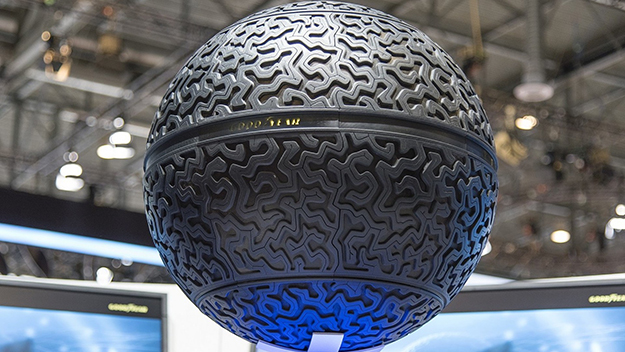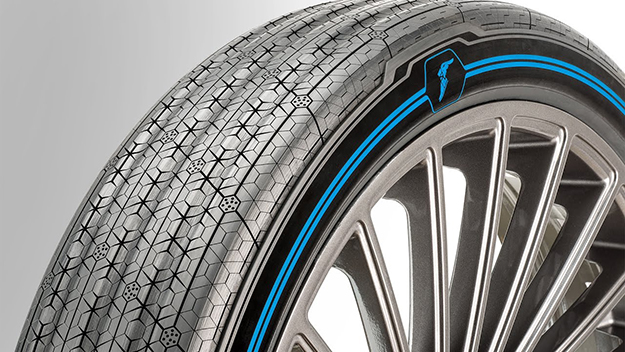
The automotive industry has experienced continuous technological advancement over the years, but as of yet, tires have seen no such change. However, the Goodyear Tire & Rubber Company plans to change that.
At the Geneva International Motor Show last March, Goodyear showcased several new and emerging technologies in its latest concept tires imagined for the future of the automotive industry.
With today’s ever-evolving mobility space, defined by the transition to driverless vehicles and shared mobility, Goodyear aims to revolutionize the interaction between tires, vehicles and their surroundings.
Goodyear introduced two innovative tires: the Eagle 360 and IntelliGrip smart tire. Some of the latest emerging technologies included are artificial intelligence, vehicle-to-everything (V2X) connectivity and an advanced sensory system.
The Eagle 360
Goodyear’s Eagle 360 features plenty of today’s technological goodies. First off it’s fully powered by artificial intelligence allowing the tire to gather data from its several sources, extract useful information and apply any needed changes.
The other nifty features include a bionicskin surface along with a full-fledged sensor network. These two features work hand in hand to feed data to the AI system and carry out AI decisions.
Sensors enable the tire to check on its own status and gather essential information on its environment - majorly road surface. After relaying the necessary data, the tire can shape-shift using its bionic skin to address the changes in road conditions.

The bionic skin is made of a super-elastic polymer and has the flexibility of human skin, giving it the ability to easily expand and contract when needed. The way it works is with the help of actuators beneath the tire’s surface.
These components change shape due to an electrical input, just like human muscles. Thus the tire can re-shape its tread design, adding ‘dimples’ for wet conditions or smoothing the tread for dry conditions.

Bionic skin also provides the tires with self-healing capabilities. So in the event that the tire is damaged, sensors in the tread can locate the puncture. In order to initiate the healing process, the tire autonomously rotates position to change to a different contact path with the road to allow for uninterrupted driving.
This reduces pressure on the puncture and allows the self-healing process to begin. The self-healing works thanks to specialized materials which flow towards the puncture. They react both physically and chemically with each other to form new molecular bonds and close any punctures or tread damage.
By combining all these sources of information and processing them instantaneously using neural networks trained with deep learning algorithms, the Eagle 360 can independently decide its most appropriate courses of action. AI also enables the Eagle 360 to learn from previous actions and interpret shared information to optimize future responses.
With V2X communication built in, Eagle 360 can share road information it has captured and the related action it has taken. The tires are able to communicate with other vehicles as well as infrastructure, traffic and mobility management systems to capture and share critical information in real-time.
You might be thinking how would one attach a spherical tire to a car. Well, the answer is, you don't. Goodyear Eagle 360 uses magnetic levitation (MagLev) to suspend the vehicle over the tires using a magnetic field.

So basically, Goodyear isn’t just planning to reinvent the tire, but automotive design as well. I’m not too sure how many automakers will be willing to spend millions of dollars to redesign their vehicles around tires, but I’m sure there won't be many.
Eagle 360 Key Features:
1. V2X communication allows the tire to:
- Gather and share real-time information about driving conditions from the tires, other vehicles, infrastructure, and traffic systems
2. Artificial Intelligence unit enables the tire to:
- Continuously sense road conditions and the surrounding environment in real-time
- Process information captured to decide what to do and learn for the future
- Transform tire tread and tire/vehicle interface
- Measure current and predict future tire wear to allow automated tire management, enabling predictive and proactive maintenance
3. Bionic skin includes a high-sensory capacity tread to:
- Optimize the morphing of the tread
- Improve vehicle braking, handling and efficiency
- Inform other tires and vehicles expected to take the same road
- Self-heal and repair any damage/punctures
4. Spherical shape provides benefits such as:
- Movement in all directions while contributing to comfort, safety and maneuverability
- Coping with space limitations in cities (small parking spaces, platoon driving in traffic and general maneuverability)
Based on the above, the appeal of these smart spherical tires is pretty clear. Take a look at how these tires would work and leverage today’s advanced technology in the real world:
The IntelliGrip
The second smart tire concept, the IntelliGrip, is designed for autonomous, on-demand transportation, particularly focused on maximizing uptime and reducing operating costs for ride sharing service providers.
Unlike the Eagle 360, the IntelliGrip maintains the usual tire design we all know today but adds some advanced technological features. Unfortunately, it doesn't have the AI capabilities and morphing bionic skin like that of the Eagle 360.
The IntelliGrip tire’s technical features aim to maximize energy efficiency, which is especially crucial for ‘Mobility as a Service’ providers to offer improved mobility to their customers.

On-demand transportation as an alternative to taxis, rental cars, or actual driving is becoming an increasingly popular service and not just to millennials - just look at the growth of Uber and Lyft. The value in convenience of immediacy, location and payment is appealing to all demographics and is bringing ride sharing services into the mainstream.
Similar to the Eagle 360, the Goodyear IntelliGrip is outfitted with an advanced Sensor-in-Tire technology, designed to support autonomous vehicle control systems and enhance passenger safety.
The concept tire can sense road and weather conditions while gathering critical data and sending it directly to the vehicle’s computer system. This enables the car to optimize speed, braking, handling and stability.
Unlike the Eagle 360, the IntelliGrip does not have the ability to take its own decisions such as morphing tire tread. Instead the vehicle itself will take the needed action required.
Another great feature is the tire’s proactive maintenance. Through telematics and tire health monitoring, fleet operators can precisely identify and resolve tire-related issues safely before they happen, thus maximizing uptime.
Moreover, thanks to the tire’s efficient tall and narrow design, rolling resistance is significantly reduced and electric vehicles can extend their overall range. In addition, the fewer tread grooves reduce noise levels and offer a more comfortable ride and longer tread life.
There is no question that autonomous technology will take over fleets and ride-sharing vehicles. They will surely be operating in a complex environment, with other vehicles, drivers, pedestrians and data from multiple elements making up the Internet of Things. Tires such as the Goodyear IntelliGrip will play a critical role in such an evolving ecosystem.
IntelliGrip Key Features:
1. Sensor-in-Tire technology provides:
- Help for autonomous cars to better read road conditions
- Support and enhancement for passenger safety and peace of mind
- Crucial Tire-to-Vehicle information exchange via the cloud
2. Proactive maintenance allows for:
- Fleet operators to precisely identify and resolve tire-related and potential safety issues before they happen
- A user-friendly solution to maximize tire performance and schedule proactive maintenance
- Reduce total cost of operations and improve the uptime, efficiency and sustainability of the fleet
3. Tall and Narrow shape design which:
- Reduces the rolling resistance of the tire in order to increase the energy efficiency and range of the electrical vehicle fleet in an urban environment.
- Contributes to improved aquaplaning performance by decreasing the amount of grooves on the tire while also increasing mileage and reducing noise levels.
4. Specially-designed tread provides:
- Grip in both winter and summer conditions
- Maximum uptime and optimized efficiency for fleets.
All in all, the IntelliGrip does seem like a more probable tire concept than the Eagle 360; take a deeper look at its key features in the video below:
It's tough to see a concept tire like the Eagle 360 actually going into production. It literally reinvents the wheel and would disrupt the entire automotive industry.
Such a design change would cost millions upon millions for automakers to implement. With today’s new safety tech features, the tire just seems unnecessary – in other words, if it ain’t broke, don't fix it.
The IntelliGrip, on the other hand, maintains typical tire design and functionality while adding some much-needed future tech. I would expect to see the IntelliGrip or some sort of variation of the tire installed on autonomous vehicles in the years to come.
Latest Business
Intelligence Report














